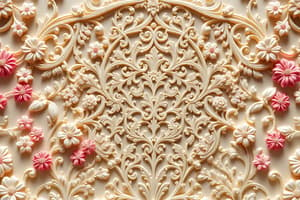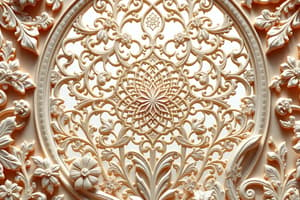Podcast
Questions and Answers
Which of the following is a key step in the Generalized AM Process Chain?
Which of the following is a key step in the Generalized AM Process Chain?
- Exporting to PDF format
- Network analysis
- Market research
- Post-processing of the part (correct)
Design for AM includes considerations like part orientation and the inclusion of undercuts.
Design for AM includes considerations like part orientation and the inclusion of undercuts.
True (A)
What does STL stand for in additive manufacturing?
What does STL stand for in additive manufacturing?
STereoLithography
The first step in the additive manufacturing process chain is __________.
The first step in the additive manufacturing process chain is __________.
Match the following types of additive manufacturing systems with their description:
Match the following types of additive manufacturing systems with their description:
What process is used after converting a CAD model to an STL file?
What process is used after converting a CAD model to an STL file?
Metal systems in additive manufacturing typically do not use substrates.
Metal systems in additive manufacturing typically do not use substrates.
Name one application area of additive manufacturing that does not involve conventional CAD modeling.
Name one application area of additive manufacturing that does not involve conventional CAD modeling.
What is a common requirement for some additive manufacturing (AM) processes during production?
What is a common requirement for some additive manufacturing (AM) processes during production?
Post-processing is not typically a manual stage of finishing parts for application purposes.
Post-processing is not typically a manual stage of finishing parts for application purposes.
Name one potential issue with parts produced through additive manufacturing when it comes to material properties.
Name one potential issue with parts produced through additive manufacturing when it comes to material properties.
Some AM processes may cause the material to degrade during the _____ stage.
Some AM processes may cause the material to degrade during the _____ stage.
Match the following stages of AM with their descriptions:
Match the following stages of AM with their descriptions:
Which of the following is a true statement about the properties of parts produced by AM?
Which of the following is a true statement about the properties of parts produced by AM?
The need for careful handling of parts during post-processing is not important for achieving good precision and finish.
The need for careful handling of parts during post-processing is not important for achieving good precision and finish.
AM materials and processes are __________ all the time.
AM materials and processes are __________ all the time.
What future trend is expected in additive manufacturing regarding material systems?
What future trend is expected in additive manufacturing regarding material systems?
Laser scanning technology is not used in reverse engineering data.
Laser scanning technology is not used in reverse engineering data.
What is the nominal layer thickness for most FDM Dimension machines?
What is the nominal layer thickness for most FDM Dimension machines?
What is a key advantage of using architectural modeling in design?
What is a key advantage of using architectural modeling in design?
Additive manufacturing may involve combining additive, subtractive, and even ______ handling phases.
Additive manufacturing may involve combining additive, subtractive, and even ______ handling phases.
Post-processing involving heat does not require knowledge of the material properties involved.
Post-processing involving heat does not require knowledge of the material properties involved.
Match the following additive manufacturing technologies with their descriptions:
Match the following additive manufacturing technologies with their descriptions:
What disadvantage do photopolymer-based systems have compared to other AM materials?
What disadvantage do photopolymer-based systems have compared to other AM materials?
The layer thickness for standard SL technology generally varies between _____ mm.
The layer thickness for standard SL technology generally varies between _____ mm.
Match the following AM processes with their characteristics:
Match the following AM processes with their characteristics:
Which factor affects the choice of layer thickness in AM technologies?
Which factor affects the choice of layer thickness in AM technologies?
Newer resins in photopolymer systems can degrade rapidly without UV protective coatings.
Newer resins in photopolymer systems can degrade rapidly without UV protective coatings.
What advantage does a powder-based system have over photopolymer-based systems?
What advantage does a powder-based system have over photopolymer-based systems?
Which of the following is a requirement for molten material systems?
Which of the following is a requirement for molten material systems?
The Thermojet process eliminates the need for support structures in droplet-based systems.
The Thermojet process eliminates the need for support structures in droplet-based systems.
What is a significant challenge in cleaning up parts produced with lamination methods?
What is a significant challenge in cleaning up parts produced with lamination methods?
Some machines using ______ technology need careful monitoring to operate effectively.
Some machines using ______ technology need careful monitoring to operate effectively.
Match the following application areas to their corresponding imaging techniques:
Match the following application areas to their corresponding imaging techniques:
Which of the following factors is NOT worth considering for metal systems?
Which of the following factors is NOT worth considering for metal systems?
Part orientation is an important consideration in the design for additive manufacturing (AM).
Part orientation is an important consideration in the design for additive manufacturing (AM).
What is one method to improve recycling in additive manufacturing?
What is one method to improve recycling in additive manufacturing?
Flashcards are hidden until you start studying
Study Notes
Generalized AM Process Chain
- Eight Step Process:
- Conceptualization and CAD: Product ideas are conceptualized in a variety of forms, ranging from text descriptions to 3D CAD models.
- Conversion to STL: The CAD model is converted to an STL (STereoLithography) file, which represents the geometry as a series of triangular facets.
- Transfer to AM Machine and File Manipulation: The STL file is transferred to the AM machine, where it is manipulated and prepared for the build process. This involves separating the part from the build platform, adding support structures if necessary, and preparing the material for printing.
- Build: The part is built layer by layer, using the specific additive manufacturing technology of the machine.
- Part Removal and Cleanup: The part is removed from the build platform and any support structures are removed. Depending on the process and material, this can be a time-consuming and skilled process.
- Post-Processing: The part is subjected to further finishing steps, such as sanding, polishing, or coating, to achieve the desired surface finish and properties. This step is highly application-specific.
- Application: The finished part is ready for its intended use. However, it is important to note that AM parts may have different properties compared to traditionally manufactured parts, such as small voids or anisotropy (different properties in different directions).
- Maintenance of Equipment: Regular maintenance of the AM machine is crucial to ensure proper operation and prevent damage. This includes monitoring delicate laser or printer technology, as well as cleaning and preventing exposure to dirt, electrical noise, or vibrations.
- Material Handling Issues: AM materials, particularly powders and resins, can be sensitive to moisture and light. Proper handling is essential to maintain material quality and prevent degradation. Recycling of unused material is also an important consideration.
- Design for AM:
- Part Orientation: Proper orientation of the part on the build platform is crucial for effective support structure removal and minimal warping.
- Removal of Supports: Designs that minimize the use of support structures, or employ easily removable supports.
- Hollowing out Parts: Hollowing out parts can reduce weight, material consumption, and build time.
- Inclusion of Undercuts and Other Manufacturing Constraints: Designing parts with undercuts, holes, or other difficult-to-manufacture features can be addressed by using specific AM processes or methods.
- Interlocking Features: Designing parts with interlocking features can facilitate assembly and reduce the need for additional fasteners.
- Reduction of Part Count in an Assembly: Designing complex parts as a single piece instead of multiple components can simplify the manufacturing process.
- Identification Marking/Numbering: Integrating identifying markings or numbers directly into the design can enhance traceability and organization.
Variations in AM Processes
- Powder-Based Systems: These systems deposit a bed of powder layer by layer and use a binder or sintering process to fuse the material.
- Photopolymer-Based Systems: These systems use photopolymerization to solidify liquid resins. This technology is generally accurate but can be fragile.
- Molten Material Systems: These systems melt and deposit materials in a molten state. Different processes utilize distinct methods like droplet-based deposition or extrusion, each having advantages in terms of support structure creation and ease of use.
- Solid Sheet Systems: These systems utilize layering of solid sheets, which are then cut and bonded together. This method eliminates the need for support structures but requires careful handling and post-processing of waste material.
Metal Systems
- Metal systems utilize similar principles as polymer systems and feature unique considerations:
- Substrates: Metal parts often require a substrate to provide stability and support during printing.
- Energy Density: Metal systems require high energy densities to melt and fuse the metal powder.
- Weight: Metal parts are heavier than their polymer counterparts, which affects build times and stability.
- Accuracy: Metal systems can achieve high levels of accuracy, but fine details might still be a challenge.
- Speed: Metal printing is generally slower than polymer or ceramic printing.
Application Areas
- Medical Modeling: 3D models created from medical scans (CT, MRI, 3D Ultrasound) aid in diagnosis, planning, and surgical procedures.
- Reverse Engineering Data: Laser scanning technology captures 3D data from existing objects for creating replicas or designing new parts.
- Architectural Modeling: Architectural models created using AM can visualize designs, explore concepts, and showcase textures, colors, and shapes in a realistic manner.
Future Considerations
- Thicker Layers and Processing Regions: Advancements in AM processes are exploring the use of thicker layers and larger processing regions to increase speed and efficiency.
- Beyond STL Files: The limitations of the STL file format for complex part designs may lead to the development of alternative formats for representing part information.
- Multi-Material Systems: The use of multiple materials and colors within a single part will become more common, requiring advanced software and processes.
- Hybrid Technologies: Integrating additive, subtractive, and robotic manufacturing techniques for further optimization and complexity.
- Software Optimization: Specialized software will be developed to optimize AM processes and streamline design workflows.
- Direct Digital Manufacturing: Increased adoption of AM will require standardized software processes and workflows for more seamless integration.
Studying That Suits You
Use AI to generate personalized quizzes and flashcards to suit your learning preferences.



